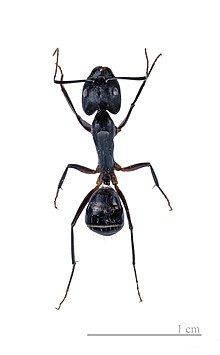
Back نملاوات أحادية الخصر Arabic نملاوات ARZ Formicins Catalan Formicinae Czech Schuppenameisen German Formikenoj Esperanto Formicinae Spanish موریان (زیرخانواده) Persian Suomumuurahaiset Finnish Formicinae French
| Formicinae Temporal range:
| |
|---|---|

| |
| Camponotus fellah | |
| Scientific classification | |
| Domain: | Eukaryota |
| Kingdom: | Animalia |
| Phylum: | Arthropoda |
| Class: | Insecta |
| Order: | Hymenoptera |
| Family: | Formicidae |
| Subfamily: | Formicinae Lepeletier, 1836 |
| Type genus | |
| Formica Linnaeus, 1758
| |
| Diversity | |
| 51 extant genera in 12 tribes | |

The Formicinae are a subfamily within the Formicidae containing ants of moderate evolutionary development.
Formicines retain some primitive features, such as the presence of cocoons around pupae, the presence of ocelli in workers, and little tendency toward reduction of palp or antennal segmentation in most species, except subterranean groups. Extreme modification of mandibles is rare, except in the genera Myrmoteras and Polyergus. However, some members show considerable evolutionary advancement in behaviors such as slave-making and symbiosis with root-feeding hemipterans. Finally, all formicines have very reduced stings and enlarged venom reservoirs, with the venom gland, specialized (uniquely among ants) for the production of formic acid.[citation needed]
All members of the Formicinae "have a one-segmented petiole in the form of a vertical scale".[2]
- ^ Grimaldi, D.; Agosti, D. (2000). "A formicine in New Jersey Cretaceous amber (Hymenoptera: Formicidae) and early evolution of the ants". Proceedings of the National Academy of Sciences. 97 (25): 13678–13683. Bibcode:2000PNAS...9713678G. doi:10.1073/pnas.240452097. PMC 17635. PMID 11078527.
- ^ Klotz, John H. (2008). "Formicinae". Urban ants of North America and Europe: identification, biology, and management. Cornell University Press. ISBN 978-0-8014-7473-6.